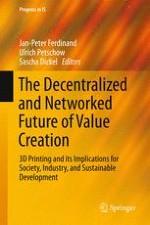2016 | OriginalPaper | Buchkapitel
Bottom-up Economics. Foundations of a Theory of Distributed and Open Value Creation
verfasst von : Tobias Redlich, Manuel Moritz
Erschienen in: The Decentralized and Networked Future of Value Creation
Aktivieren Sie unsere intelligente Suche, um passende Fachinhalte oder Patente zu finden.
Wählen Sie Textabschnitte aus um mit Künstlicher Intelligenz passenden Patente zu finden. powered by
Markieren Sie Textabschnitte, um KI-gestützt weitere passende Inhalte zu finden. powered by
